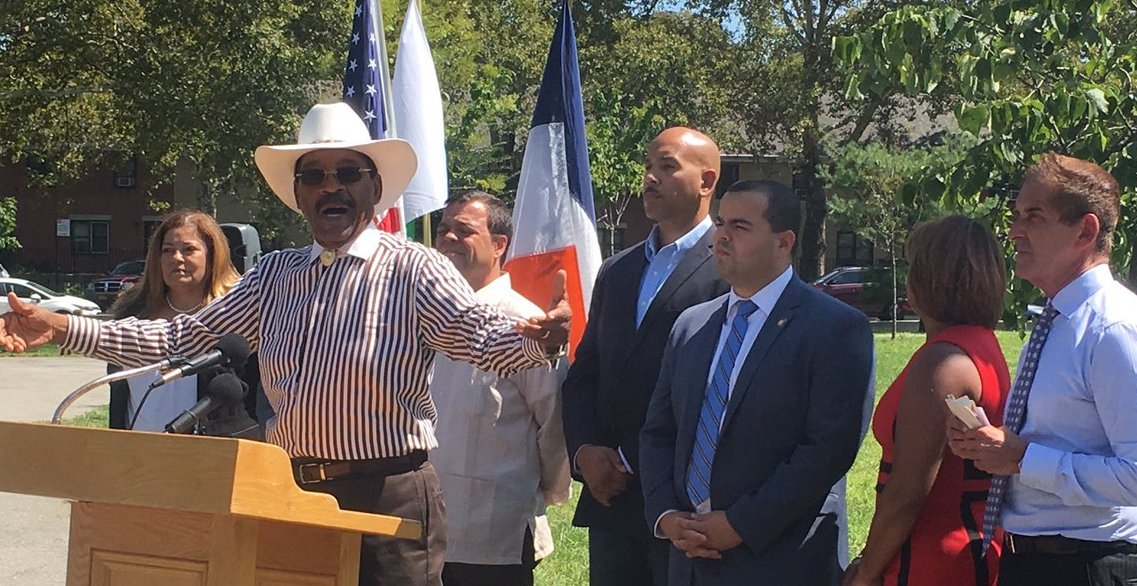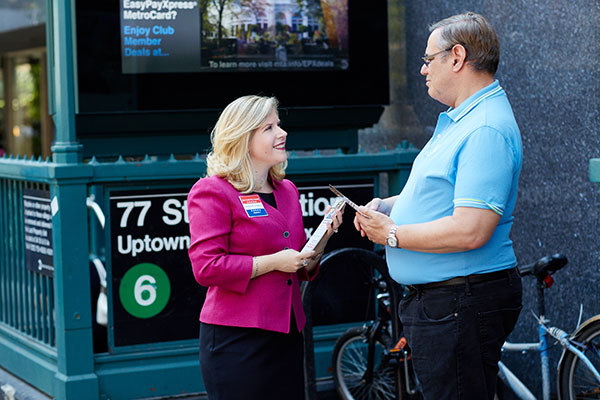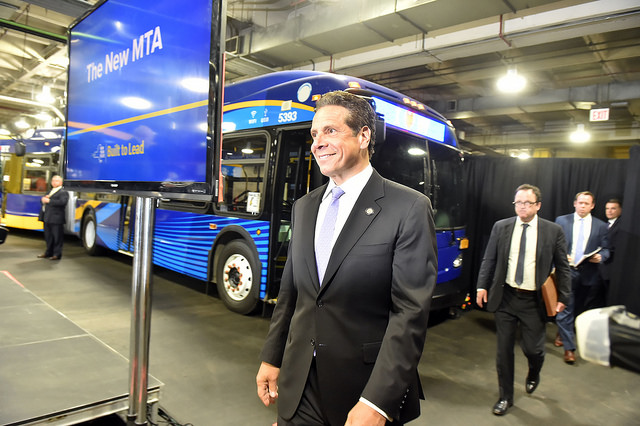The Threat Lurking on Primary Day

State Senator and City Council candidate Ruben Diaz Sr. (photo: @RevRubenDiaz)
The New York City Council is under threat. There is a force exerting immense pressure to dangerously influence the session beginning in January. That threat goes by one name: Albany. And it is bearing down on the city this week.
We need to take stock of what is happening, and vote accordingly on Tuesday, September 12, or the 2018 City Council class will be far less progressive than the current.
What do I mean by the Albany threat? State legislators who represent people from New York City who are eager to get out of working in Albany and are running for the City Council. They have experience in campaigns with far fewer restrictions to keep them accountable to voters. Their experience as policy-makers is one where they are completely constrained by the leaders at the top and far less serious about the work of an elected official with legislative, oversight, and constituent service responsibilities.
These Assembly members and Senators have mostly accepted an unethical and unacceptable state government as it is, sought to bring some funding back to their districts, and cast blame around for the lack of beneficial policy results. Seeking easier commutes and a substantial pay raise, several state legislators are seeking seats in the City Council this year, with Tuesday’s primary elections set to determine the overall winners and losers given the city’s Democratic advantage. In order to run this year, these legislators don’t have to risk their seats, and with the power of name recognition and fundraising that accompanies being an elected official already, they have distinct advantages, no matter how good their opponents may be.
The worst case scenario is an eventual takeover, given the handful of potential migrants this year and the floodgates that could open in 2021, when many more Council seats will be open due to term limits. Voters must take a stand this year. And while it should be done on a candidate by candidate basis, overall, the threat of Albany must be beat back.
A quick survey of some of the contested Council seats confirms this Albany threat is real. In Brooklyn, City Council Member Carlos Menchaca is threatened by Assemblymember Felix Ortiz, whose main accusation is that Menchaca isn’t good at constituent services. In Queens, two Albany people are fighting for City Council Member Ferraras-Copeland’s seat, and the progressive city is quivering that a former Albany gargoyle, Hiram Monserrate, will be defeated by a current state legislator who is hopefully not anywhere near as bad.
In both City Council District 13 in the Bronx and District 8, which includes parts of East Harlem and the South Bronx, the competition pits a male Assembly member against a strong female candidate with positive community experience and a bright future.
In the Bronx, State Senator and Reverend Ruben Diaz Sr. announced that he is entitled to run for the City Council and that he eschews calls for separating religious and government work because, “I am the Church and the State.” He’s sucked up all the air in the room with a slew of major endorsement and his name recognition, and he’ll likely shut the door of opportunity on qualified candidates seeking their first elected office.
Also worth noting, then-State Senator Bill Perkins already nabbed the Harlem City Council seat in a special election earlier this year, and will likely ride the incumbency power to a victory this fall, despite other candidates ready to serve.
Not all of these Albany legislators are terrible as individuals. Some state legislators go to the capital to fight for and deliver change. But voters should wonder why each one attempting to leave is ready to jump ship and carefully consider the options on the ballot.
Is this current exodus from Albany representative of a strategic effort to tamp down the policy-driven New York City Council? That Council has moved a great deal of progressive policy over the last four years. Continuing in that direction is under threat.
Do these legislators just want a pay raise? It’s a question worth asking.
Most Albany legislators’ City Council campaigns echo themes of “I provide good constituent services so you should vote for me,” regardless of whether they have a record to stand on. They prioritize their constituent services to ingratiate themselves to their voters without actively seeking out ways to fix broken systems. While the Council’s current members are full of imperfections, the last four years have been full of real efforts to make government better for New Yorkers.
“Elections have consequences” was one of the themes that finally landed after the 2016 presidential. The consequences in New York City of the Albany influx will be many—number one, as new members they could block the victory of a potential progressive Speaker of the Council, which could then very easily halt real and important policy changes. They could defer to Albany’s typical priorities of promoting the interests of real estate developers and coming up with excuses for failing to fix healthcare, support immigrants, and achieve ethics reform.
If Albany sees a way in this year, we can be assured that in four years when most of the Council races will not have incumbents, many more state legislators will attempt to get out of Albany, intensifying this threat.
Elections do indeed have consequences. One could be a lot more Albany status-quo do-nothings elected in New York City; another could be a risk-taking, people-oriented Council for the next four years.
***
Richard Semegram is a tenant attorney in Manhattan. On Twitter @richagram.
***
Have an op-ed idea or submission for Gotham Gazette? Email This email address is being protected from spambots. You need JavaScript enabled to view it.
Dig Just Once to Tackle Noise Pollution and Get More Done

Vanessa Aronson, left, is the author (photo: Aronson campaign)
Sometimes it sounds like machine gun fire. Sometimes like the wail of a banshee. Sometimes like a wheezing dragon. And sometimes like all three at the same time.
I’m talking about the jackhammers, construction equipment and crews digging up your street for power cables, sewer work, and high-speed internet conduits. It’s an unfortunate part of New York City living. But it doesn’t have to be that way, especially for broadband fiber optics.
New York City must deal with its noise pollution, and should quickly adopt a Dig Once policy, which would lower the cost of broadband expansion by doing two things:
One, requiring city utilities to coordinate digging schedules so that they accomplish what needs to be done efficiently. And two, Installing fiber optic conduit when the ground is dug up for other projects.
By installing fiber conduit with enough space for additional networks, we can limit the need for new construction, meaning digging new holes and trenches every time new fiber is required. That way the cost of that construction is amortized over all projects that later use the conduit. This not only reduces costs but also minimizes hazards and headaches for drivers, pedestrians, business owners, visitors, and residents. All while adding less than one percent to the total cost of the construction.
And Dig Once works.
The Dig Once policy is already in place statewide in Arizona, Minnesota, and Utah, as well as in Boston and San Francisco.
Simply put, this policy can save money by minimizing the amount of digging and noise, and reduce inconvenience when installing necessary conduits and cables. Successfully implementing a Dig Once policy is based on leveraging the “rights of way” that are owned and managed by many different utilities and communications companies.
At a state level Dig Once broadens the authority of the state’s Department of Transportation to include the transportation of information. This allows the agency to coordinate the installation of multi-user conduits in state highways.
At a city level, Boston’s Dig Once is a “joint build” policy that requires all telecom companies to install their cable in shared underground conduits on a shared-cost basis. This policy also designates a “lead company” that is tasked with coordinating efforts between all involved in the installation process, planning and implementing the installation.
San Francisco’s Dig Once Specification has lowered the cost of conduit installation from $128,000 per street mile for the first installation (including excavation) to $71,000 for the second.
Although there is no federally mandated policy, U.S. Executive Order 13616 directed the U.S. Department of Transportation to review Dig Once requirements and to work with state and local governments in the development and implementation of sensible construction policies including Dig Once.
If the U.S. adopts a Dig Once policy, construction workers would install conduits just about any time they excavate for new roads and dig up your sidewalk. But we’re New Yorkers. We shouldn’t have to wait for Washington to save us money and time, and from the assault of jackhammers. We can -- and should -- Dig Once now.
***
Vanessa Aronson is a Democratic candidate for City Council in District 4. On Twitter @VanessaAronson.
***
Have an op-ed idea or submission for Gotham Gazette? Email This email address is being protected from spambots. You need JavaScript enabled to view it.
Congestion Pricing Won't Solve New York's Transportation Woes

Gov. Cuomo and a bus (photo: Kevin P. Coughlin/Governor's Office)
Governor Andrew Cuomo’s recent vague interest in congestion pricing as a solution to problems at the MTA may give new life to one of former Mayor Michael Bloomberg’s key policy goals, but absent transportation improvements officials could be making now, pricing will not save our subways. We cannot let them off the hook in search of the perceived silver bullet of congestion pricing.
The transportation community has been salivating over Cuomo’s statement that “congestion pricing is an idea whose time has come,” hoping that the governor will be able to convince the state to put a cordon toll around Manhattan south of 60th Street. Such a cordon toll, which would charge drivers entering the area on a daily or per trip basis, is reflective of similar policies elsewhere, particularly London, which implemented a congestion charge in the central city district in February 2003. Yet commenters and policy nerds this side of the Atlantic have missed the real substance of London’s improvements, and in doing so, they are giving our elected officials a pass on work they should be doing right now, regardless of the status of the pricing proposal.
What today’s transportation advocates are missing is that the key ingredient to London’s success was not its charge but its buses.
Beginning in 1993, ridership on London’s double-deckers increased annually, and was up 37% by the time the charge was implemented in 2003. In 2004, London’s buses carried more passengers than the New York City subway. While those ridership numbers are impressive on their own, what they signify is an overall shift away from cars to buses, bikes, and walking. London’s congestion charge was envisioned as a specifically anti-car policy, designed to make it easier for buses and taxis to traverse the city center.
When New York City congestion pricing advocates see London’s roads covered in bus lanes, they may imagine that the charge enabled such a shift, freeing up road space to then be taken over by buses and bikes. In fact, nearly all of London’s 180 miles of bus lanes were implemented before the congestion charge, in that era of increasing ridership between 1993 and 2003. The lanes and other improvements insulated London’s buses from congestion enough, even before the charge, to improve rider experience and reduce excess waiting time at stops. Combined with a lower fare on buses compared to the tube, the operational improvements led to increased ridership and declining car use before the charge policy was even developed.
New York’s bus system pales in comparison.
The city currently has just over 50 miles of bus lanes. While buses have priority at most intersections in London, such priority only exists in New York on four Select Bus Service routes. As congestion has risen, bus ridership has fallen as bus speeds have slowed to a level barely faster than walking.
Nowhere is the lack of bus priority more egregious than on the East River bridges, the very place tolls would be implemented. When Mayor Bloomberg signed the initial contract with the USDOT for his congestion pricing proposal, East River bus lanes were the only specific bus improvement named. When the deal fell through, the East River bus lanes plan mostly died.
There are high-occupancy vehicle (HOV) lanes, used by both buses and cars with two or more occupants, in the tunnels and in the mornings on the Queensborough and Manhattan Bridges. The tunnel HOV lanes serve the express buses, the second-most heavily subsidized way to travel in the city after the commuter rail. Currently, the Queensborough bridge carries three local routes and 18 express routes. There are no buses that cross the Manhattan Bridge and benefit from the HOV lane.
For New York’s system to match London’s status before the charge was implemented, we need not only priority for buses on the roads but also more local buses into Manhattan. Based on London’s experience, getting drivers out of their cars requires a double shift.
First, some subway riders shift to buses for shorter trips; then drivers, who generally take longer trips, switch to the newly opened subway space. New York’s bus system largely lacks bus routes to accommodate people switching from the subway to bus. Currently, only a single local bus goes from Brooklyn to Manhattan, the B39, which runs only between the Williamsburg Bridge Terminal and Delancey Street, and comes every half hour. Unsurprisingly, it has the lowest ridership in the bus system. Without more direct bus connections to Manhattan, New York severely limits the bus system’s ability to provide a subway relief valve.
To be clear, there are activists calling for New York to focus on its bus network, but the centrality of the bus network to the functioning of the whole system is not fully depicted. The Bus Turnaround Campaign, comprised of the Riders Alliance, TransitCenter, TriState Transportation Campaign, and the Straphangers Campaign, have called for bus improvements for the sake of riders, but not as a way of improving transportation in the city as a whole, though their recommendations are based in part on London’s improvements, including increased bus priority, less circuitous routing, and improved fare payment.
What is frustrating is that many advocates believe that they have to support the pricing proposal in order to achieve bus system improvements, and that others feel as though they don’t need to advocate as hard for buses because the charging regime will magically improve the buses. The reality is that absent good alternatives to switch to, any charge that is politically feasible (maybe no more than the cost of a subway fare, well short of what is proposed in the most thorough proposal to-date, the Move New York plan) will be ineffective at reducing congestion and thus at improving the buses. London’s temporary drop in congestion following the charge was made possible by the bevy of available bus seats. While New York has available bus seats, they are not yet good alternatives. If they were, we would have seen bus ridership increase during this especially difficult subway summer congestion pricing is supposed to fix, and we didn’t.
If New York wants to seriously improve the transportation system, it needs an all-out campaign on the buses, one with the same level of media attention given to a single Cuomo quote on congestion pricing. Because so much of the bus system is about how we prioritize our roads, this is a goal that a city mayor can actually make a significant dent in without the governor, the kind of transportation improvement our mayor enjoys. So rather than wait for Governor Cuomo to save us via a pricing system that won’t work in our current system, let’s appoint a congestion czar and get serious about a transportation system that provides affordable access for all.
***
Rosalie Ray is a PhD student in Urban Planning at Columbia University. Her research focuses on London's bus improvements in the 1990s and early 2000s.
***
Have an op-ed idea or submission for Gotham Gazette? Email This email address is being protected from spambots. You need JavaScript enabled to view it.




